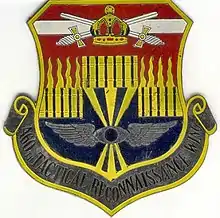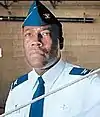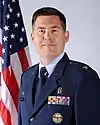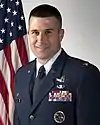460th Space Wing
The 460th Space Wing was the United States Space Force's space-based infrared surveillance, tracking, and missile warning wing. the 460th Space Wing was assigned to Space Operations Command and stationed at Buckley Air Force Base. The 460th Space Wing was activated on 1 October 2001, replacing the 821st Space Group. It was inactivated on 24 July 2020 and replaced by the Buckley Garrison.
| 460th Space Wing | |
|---|---|
 Shield of the 460th Space Wing | |
| Active | 19 May 1943[1]–24 July 2020[2] |
| Country | |
| Branch | |
| Type | Space wing |
| Role | Space-based infrared surveillance, tracking, and missile warning |
| Part of | Space Operations Command |
| Garrison/HQ | Buckley Air Force Base, Colorado, U.S. |
| Motto(s) | Persistent Global Surveillance[3] |
| Engagements | Southern France Northern Apennines Po Valley Air Offensive, Europe Normandy Northern France Rhineland Central Europe Air Combat, European-African-Middle East Theater |
| Decorations | |
| Website | Unit website |
| Commanders | |
| Commander | Col Devin R. Pepper[4] |
| Vice Commander | Col Richard L. Bourquin |
| Command Chief | CCM Robert J. Devall |
Operations
The 460th Space Wing was the United States Space Force's space-based infrared surveillance, tracking, and missile warning wing. The 460th Space Wing operated the Space-Based Infrared System (SBIRS) and the Defense Support Program (DSP).
The 50th Space Wing was also the host unit for Buckley Air Force Base, providing base support for the Colorado Air National Guard's 140th Wing, the Navy's Operational Support Center Denver, the National Reconnaissance Office's Aerospace Data Facility-Colorado, the Army's Aviation Support Facility, and the Air Force's Air Reserve Personnel Center.[5]
Structure in 2020
460th Operations Group (460 OG)[6]
- 460th Cyber Squadron (460 CS)
 2nd Space Warning Squadron (2 SWS)
2nd Space Warning Squadron (2 SWS) 11th Space Warning Squadron (11 SWS)
11th Space Warning Squadron (11 SWS) 460th Operations Support Squadron (460 OSS)
460th Operations Support Squadron (460 OSS) 460th Space Communications Squadron (460 SCS)
460th Space Communications Squadron (460 SCS)
460th Mission Support Group (460 MSG)
 460th Civil Engineer Squadron (460 CES)
460th Civil Engineer Squadron (460 CES)- 460th Contracting Flight (460 CONF)
- 460th Force Support Squadron (460 FSS)
- 460th Logistics Readiness Squadron (460 LRS)
 460th Security Forces Squadron (460 SFS)
460th Security Forces Squadron (460 SFS)
![]() 460th Medical Group (460 MDG)
460th Medical Group (460 MDG)
- 460th Healthcare Operations Squadron (460 HCOS)
- 460th Operational Medical Readiness Squadron (460 OMRS)
![]() 460th Comptroller Squadron (460 CPTS)
460th Comptroller Squadron (460 CPTS)
History
460th Bombardment Group

The 460th Bombardment Group (Heavy), was activated at Alamogordo Army Air Field, New Mexico on 1 July 1943,[7] with the 760th, 761st, 762d, and 763d Bombardment Squadrons assigned.[8] A cadre of the unit's air echelon went to Orlando Army Air Base, Florida for specialized training with the Army Air Forces School of Applied Tactics. In August, the unit was filled out with ground personnel at Kearns Army Air Base, Utah, then moved to Chatham Army Air Field, Georgia to complete its training with Consolidated B-24 Liberator heavy bombers.[9] Upon completing training, the squadron departed for the Mediterranean Theater of Operations in January 1944.[7]
The group completed its deployment to Spinazzola Airfield, Italy by the middle of February 1944, and entered the strategic bombing campaign against Germany the following month, with an attack on a marshalling yard and docks at Metković, Yugoslavia.[10] It attacked oil refineries and storage facilities, railroads, industrial areas, including aircraft manufacturing plants in Austria, Czechoslovakia, France, Germany, Greece, Hungary, Italy, Romania and Yugoslavia.[7]
On 26 July 1944, group formation led the 55th Bombardment Wing on an attack against an airfield and aircraft manufacturing plant at Zwolfaxing, Austria. It attacked the target through heavy enemy flak and adverse weather, for which it was awarded a Distinguished Unit Citation.[7]
The group was occasionally diverted from the strategic bombing mission to perform air interdiction and close air support missions. In August 1944, it supported Operation Dragoon, the invasion of southern France by attacking submarine pens, marshalling yards and artillery batteries in the area of the amphibious landings. It struck lines of communications, railroads, ammunition dumps and other targets in connection with Operation Grapeshot, the allied offensive in Northern Italy.[7] The 460th was redesignated as the 460th Bombardment Group, Heavy on 3 September 1944.[1] The group flew its last mission against a target in northern Italy on 26 April 1945.[10]
After V-E Day, the 460th Bombardment Group and its squadrons were transferred to the South Atlantic Division, Air Transport Command, moving to Parnamirim Field, near Natal, Brazil to participate in the Green Project. Green Project was aimed at transporting 50,000 military personnel a month from the European and Mediterranean Theaters back to the United States, with priority for those that plans called for redeploying to the Pacific.[11] The 460th Bombardment Group was inactivated on 26 September 1945.[8]
460th Tactical Reconnaissance Wing

On 18 February 1966, the 460th Tactical Reconnaissance Wing was organized and entered the Vietnam War.[12] It supported 2d Air Division and the Military Assistance Command Vietnam (MACV).
When it stood up, the 460th TRW, alone, was responsible for the entire reconnaissance mission, both visual and electronic reconnaissance, throughout the Southeast Asia (SEA) area of responsibility. On 18 February 1966 the 460th TRW began with 74 aircraft of various types. By the end of June 1966, that number climbed to over 200 aircraft. On 15 October 1966, the 460th TRW assumed responsibilities for all depot-level aircraft maintenance responsibility for all USAF organizations in South Vietnam.
Toward the end of 1966, the 460th TRW's responsibilities changed. First, on 18 September 1966, the 432d Tactical Reconnaissance Wing was activated at Takhli Royal Thai Air Force Base, Thailand. After the 432d TRW activated it took control of the reconnaissance squadrons in Thailand, and the 460th TRW was no longer responsible for all air reconnaissance missions throughout SEA. However, the 460th TRW provided the new 432d TRW with continued support in recovering McDonnell RF-101 Voodoo and McDonnell RF-4C Phantom II aircraft returning from high priority, high interest target missions.
Being one of two reconnaissance wings supporting SEA there were few military operations that did not involve the wing. Not only did the 460th TRW provide electronic and photo reconnaissance, the Wing's electronic capabilities allowed it to provide electronic counter measure support to Boeing B-52 Stratofortresses returning from striking targets in North Vietnam. The Wing even gave support to the Cambodian military against the North Vietnam and Viet Cong forces, as well as support to U.S. units operating inside Cambodia.
As the Vietnamization Improvement and Moderization Program began, Vietnamese crews began flying with Douglas EC-47 crews from the 360th Tactical Electronic Warfare Squadron and 6994th Security Squadron on 8 May 1971, to get training on operating the aircraft and its systems. The wing was inactivated on 31 August 1971.[12]
460th Tactical Reconnaissance Group

In January 1984, the 460th Tactical Reconnaissance Wing and 460th Bombardment Group were consolidated into a single unit. On 19 September 1989 it was redesignated the 460th Tactical Reconnaissance Group, and on 1 October 1989, reactivated at Taegu Air Base, South Korea.[12] Behind this activation was Pacific Air Forces's (PACAF) portion of Phase II of an Air Staff programming plan, Commando Flash.
Activating the 460th and relocating the 15th Tactical Reconnaissance Squadron with its RF-4C Phantom IIs from Kadena Air Base, Japan to Taegu accomplished several PACAF objectives. This activation maintained Taegu as a main operating base, allowed the RF-4C crews to train in their actual wartime operating area, placed reconnaissance aircraft near North Korea, and reduced the temporary duty costs for PACAF. Upon its activation, the 460th reported directly to 7th Air Force. During its time at Taegu, the group participated in several local and PACAF exercises designed to maintain the readiness of US forces stationed around the Korean demilitarized zone and other units designated as support units should North Korea invade South Korea again.
A year later, 1 October 1990, the 460th was inactivated along with the 15th Squadron. Some of the group's subordinate units remained active after the group's inactivation. The 460th Consolidated Aircraft Maintenance Squadron remained active until 15 October 1990. On 1 July 1991, the 460th Combat Support Squadron finally inactivated.
460th Space Wing
On 1 October 2000, the United States Air Force assumed control of the former Buckley Air National Guard Base and assigned it to the 821st Space Group to oversee its operations. On 1 October 2001, the 460th Air Base Wing was reactivated to assume installation support responsibilities for what became Buckley Air Force Base.[13]
Under the 460th ABW's command, the base underwent an extensive modernization program to improve the base's support facilities. The 460th ABW oversaw construction of one of the largest Defense Commissary Agency base commissary and Army and Air Force Exchange Service base exchange complexes in the Air Force, as well as a fitness center, dorms, and other housing areas for Buckley Airmen.[13]
On 19 August 2004, the wing was redesignated as the 460th Space Wing. It assumed command of the base's satellite missile warning mission from the 21st Space Wing, while retaining installation host and support functions. Today, the 460th delivers global infrared surveillance, tracking and missile warning for theater and homeland defense and provides combat commanders with expeditionary warrior Airmen.[14]
On 20 December 2019 the 460th Space Wing, along with the rest of Air Force Space Command, were transferred into the United States Space Force.[15]
Commanders
| No. | Commander | Term | |||
|---|---|---|---|---|---|
| Portrait | Name | Took office | Left office | Duration | |
| 1 | Colonel Allen Kirkman Jr. | 30 June 2003 | 20 June 2005 | 2 years, 0 days | |
| 2 | Colonel David W. Zeigler | 20 June 2005 | 12 June 2007 | 1 year, 347 days | |
| 3 | Colonel Donald W. McGee Jr. | 12 June 2007 | 19 June 2009 | 2 years, 7 days | |
| 4 | Colonel Clinton E. Crosier | 19 June 2009 | 11 July 2011 | 2 years, 22 days | |
| 5 | Colonel Daniel A. Dant | 11 July 2011 | 28 June 2013 | 1 year, 352 days | |
| 6 | Colonel Daniel D. Wright III | 28 June 2013 | 12 June 2014 | 349 days | |
| 7 | Colonel John W. Wagner | 12 June 2014 | 12 August 2016 | 2 years, 61 days | |
| 8 | Colonel David N. Miller Jr. | 12 August 2016 | 12 January 2018 | 1 year, 153 days | |
| 9 | Colonel Troy L. Endicott | 12 January 2018 | 3 May 2019 | 1 year, 111 days | |
| 10 | Colonel Devin R. Pepper | 3 May 2019 | 24 July 2020 | 1 year, 279 days | |
See also
- 137th Space Warning Squadron (140th Wing)
- 516th Air Service Group World War II support organization for 460th Bombardment Group
- B-24 Liberator units of the United States Army Air Forces
- List of B-57 units of the United States Air Force
- List of Douglas C-47 Skytrain operators
References
Notes
- https://www.afhra.af.mil/About-Us/Fact-Sheets/Display/Article/433979/460-space-wing-afspc/
- https://www.spaceforce.mil/News/Article/2287005/space-force-begins-transition-into-field-organizational-structure
- https://www.buckley.af.mil/Portals/13/documents/2016%20Heritage%20Booklet.pdf?ver=2016-12-27-161000-643
- https://www.buckley.af.mil/About-Us/Biographies/
- https://www.buckley.af.mil/About-Us/Fact-Sheets/Article/322399/460th-space-wing/
- https://www.buckley.af.mil/Units/
- Maurer, Combat Units, p. 335
- Maurer, Combat Squadrons, pp. 741–743
- Glantzburg, Hughes. "460th Bombardment Group (H): History of the 460th Bombardment Group". 15af.com. Retrieved 7 June 2019.
- Glantzburg, Hughes. "460th Bombardment Group (H): 460th Bombardment Group Targets 1944–1945" (PDF). 15af.com. Retrieved 7 June 2019.
- Heck, pp. 216–217
- Bailey, Carl E. (23 May 2018). "Factsheet 460 Space Wing (AFSPC)". Air Force Historical Research Agency. Retrieved 14 June 2019.
- "History of Buckley Air Force Base". Archived from the original on 12 February 2008. Retrieved 13 October 2008.
- "Buckley AFB 460th Space Wing Fact Sheet". Retrieved 29 December 2019.
- https://www.buckley.af.mil/Units/460th-Space-Wing/
Bibliography
![]() This article incorporates public domain material from the Air Force Historical Research Agency website http://www.afhra.af.mil/.
This article incorporates public domain material from the Air Force Historical Research Agency website http://www.afhra.af.mil/.
- Heck, Frank H (1955). "Traffic Homeward Bound" (PDF). In Craven, Wesley F; Cate, James L (eds.). The Army Air Forces in World War II. VII. Chicago: University of Chicago Press. LCCN 48003657. OCLC 704158. Retrieved 17 December 2016.
- Maurer, Maurer, ed. (1982) [1969]. Combat Squadrons of the Air Force, World War II (PDF) (reprint ed.). Washington, DC: Office of Air Force History. ISBN 0-405-12194-6. LCCN 70605402. OCLC 72556. Retrieved 17 December 2016.
- Maurer, Maurer, ed. (1983) [1961]. Air Force Combat Units of World War II (PDF) (reprint ed.). Washington, DC: Office of Air Force History. ISBN 0-912799-02-1. LCCN 61060979.
- Ravenstein, Charles A. Air Force Combat Wings, Lineage & Honors Histories 1947–1977. Washington, DC: Office of Air Force History. ISBN 0-912799-12-9.
- Watkins, Robert A. (2009). Insignia and Aircraft Markings of the U.S. Army Air Force in World War II. Volume IV, European-African-Middle Eastern Theater of Operations. Atglen,PA: Shiffer Publishing, Ltd. ISBN 978-0-7643-3401-6.

.jpg.webp)

.jpg.webp)




.jpg.webp)



.svg.png.webp)

.jpg.webp)